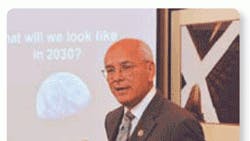Danfoss Participates in New York City Energy Briefing
Danfoss, in conjunction with the Alliance to Save Energy, co-sponsored a briefing and reception in New York City: "Energy Efficiency: The Path to NYC's Residential Transformation."
The event was held on September 15. It was intended to highlight New York’s state and local energy initiatives, in the absense of a national energy policy, which attendees believe is needed. New York-based consulting engineers, property and facility managers, and representatives from cooperative housing units gathered to explore the goals and challenges facing New York City. They also shared information on energy savings realized from a recent heating technology installation in two NYC multifamily residential buildings.
Presenters included:
- Congressman Paul Tonko (D-NY), U.S. House of Representatives
- Francis Murray, president/CEO, New York State Energy Research and Development Authority (NYSERDA)
- Kateri Callahan, president, Alliance to Save Energy
- Deborah Taylor, chief sustainability officer, NYC Department of Buildings
- Tom Sahagian, green codes fellow, NYC Mayor's Office of Long-Term Planning & Sustainability
- Robert Wilkins, vice president public affairs, Danfoss.
The Energy Challenge
In his opening remarks, Robert Wilkins restated the fact that buildings account for 40% of the energy used in the U.S. today, primarily for heating and cooling, and issued a challenge.
"We — as building owners, operators, engineers and manufacturers—have a tremendous opportunity to help move the needle in terms of reducing energy use, decreasing tenant costs, improving comfort, and putting our buildings on the path to a more sustainable future; not to mention increasing buildings' rental or resale value," Wilkins said.
Deborah Taylor presented information from New York City's "Greener, Greater Buildings" plan, which is part of Mayor Michael Bloomberg's PlaNYC initiative. She spoke of the breakdown of the city’s greenhouse gas (GHG) emissions. "Of the 49.3 million metric tons of carbon dioxide (CO2) measured in 2009, 35% are produced by residential buildings,"she said.
Programs Reduce Usage, Emissions
Kateri Callahan described energy programs that are helping to build a more energy-efficient future through financing, including Property Assessed Clean Energy (PACE) Bonds, President Obama's Better Buildings Initiative — which aims for a 20% improvement in energy efficiency in existing commercial buildings by 2020 — and improved building codes.
According to Callahan, implementation of the 2009 International Energy Conservation Code (IECC) and ASHRAE Standard 90.1 2007 statewide in 2011 could save $178 million annually by 2020 and $360 million annually by 2030 in avoided energy costs, and greatly reduce carbon dioxide (CO2) emissions. She said improving residential building energy codes, and ensuring homeowners have the resources to make necessary energy upgrades, can help make average cost-of-living values more acceptable. According to Callahan, the average annual U.S. home energy bill is about $2,175.
Resources touted by city authorities include energy audits to evaluate building envelopes, HVAC, hot water, lighting, power, elevators, escalators, and more, to identify potential energy upgrades.
TRVs for Multi-family Units
Tom Sahagian presented a case study of the effect of thermostatic radiator valves (TRVs) in New York City’s multifamily housing cooperatives.
He said the city's 1.7 million multifamily housing units account for more than half of the city’s total occupied housing units. Most, he said, were built without individual thermostat controls. Therefore, it's commonplace, when an apartment becomes too warm, for tenants to open windows to control temperature. This is a large source of wasted energy.
TRVs are easy to install on steam and hot water radiators and convectors. A TRV allows only the required amount of steam or hot water to enter the radiator and/or convector, to match changing heating requirements throughout the day.
Congressman Tonko stated his belief that energy efficiency is a matter of national security and economic growth. "There are technologies available today to affect and radically improve the efficiencies of U.S. buildings and homes, and the country needs to continue investing in technologies of the future," he said. To learn more about thermostatic radiator valves, visit http://radiatorcontrol.com/.
